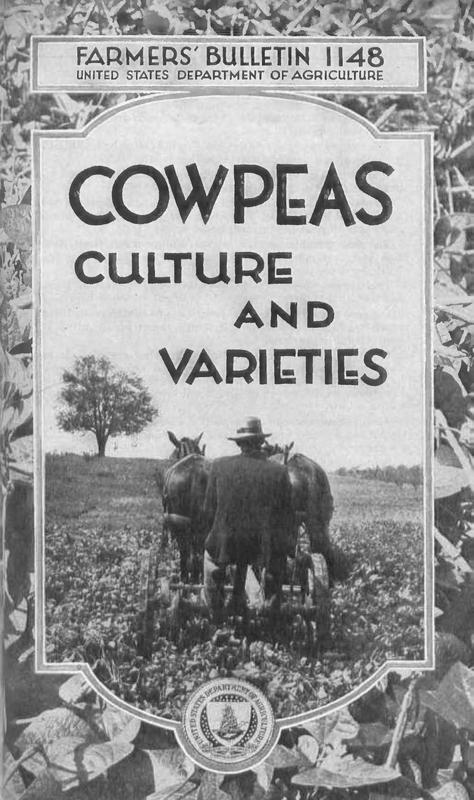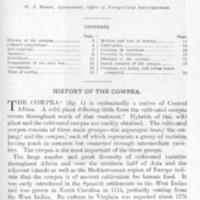Cowpeas: Culture and Varieties
Creator
Date
1920
Excerpt
THE COWPEA is the best known and most extensively grown leguminous crop in the Southern States. It is grown mainly for forage and to improve the soil, but the seeds are rather commonly used for human food.
The cowpea is of the greatest value in the cotton belt, although it can be grown profitably much farther north.
The cowpea will do best on sandy loams, but will succeed on practically all types of well-drained soil.
To obtain the best results with cowpeas, poor or unproductive soils should be fertilized with about 300 pounds of acid phosphate and 50 pounds of potash to the acre.
The most valuable varieties are the Whippoorwill, Groit, New Era, and Brabham for seed or hay and the Blackeye or the White for table use.
The cowpea should not be sown before corn-planting time, and usually it is better to wait until at least two weeks later.
For seed production the best practice is to sow in rows 3 feet apart, while for forage or soil improvement broadcasting is most generally practiced.
Cowpeas grown in combination with other crops, such as sorghum, Sudan grass, Johnson grass, and millet, produce a larger yield of hay, which is more easily handled and cured than cowpeas grown alone and constitutes a better balanced ration.
The cowpea succeeds under such a wide range of conditions that it can be used to good advantage in almost any system of rotation.
Root-knot and wilt, the two diseases most serious to the cowpea in the United States, may be controlled largely by growing such resistant varieties as the Iron, Brabham, and Victor and by rotating with crops not affected.
The most serious insect enemies of the cowpea are the cowpea weevil and the 4-spotted bean weevil, both of which cause considerable damage to the seed. These weevils may be easily controlled if proper methods are employed in caring for the seed.
As a summer annual the cowpea is brought more or less into competition with velvet beans and soy beans. In the regions adapted to these crops the cowpea succeeds for general purposes under a greater diversity of conditions.
The cowpea is of the greatest value in the cotton belt, although it can be grown profitably much farther north.
The cowpea will do best on sandy loams, but will succeed on practically all types of well-drained soil.
To obtain the best results with cowpeas, poor or unproductive soils should be fertilized with about 300 pounds of acid phosphate and 50 pounds of potash to the acre.
The most valuable varieties are the Whippoorwill, Groit, New Era, and Brabham for seed or hay and the Blackeye or the White for table use.
The cowpea should not be sown before corn-planting time, and usually it is better to wait until at least two weeks later.
For seed production the best practice is to sow in rows 3 feet apart, while for forage or soil improvement broadcasting is most generally practiced.
Cowpeas grown in combination with other crops, such as sorghum, Sudan grass, Johnson grass, and millet, produce a larger yield of hay, which is more easily handled and cured than cowpeas grown alone and constitutes a better balanced ration.
The cowpea succeeds under such a wide range of conditions that it can be used to good advantage in almost any system of rotation.
Root-knot and wilt, the two diseases most serious to the cowpea in the United States, may be controlled largely by growing such resistant varieties as the Iron, Brabham, and Victor and by rotating with crops not affected.
The most serious insect enemies of the cowpea are the cowpea weevil and the 4-spotted bean weevil, both of which cause considerable damage to the seed. These weevils may be easily controlled if proper methods are employed in caring for the seed.
As a summer annual the cowpea is brought more or less into competition with velvet beans and soy beans. In the regions adapted to these crops the cowpea succeeds for general purposes under a greater diversity of conditions.
Title
Cowpeas: Culture and Varieties
File(s)
Cowpeas Culture and Varieties cover.jpg
(image/jpeg)
Cowpeas Culture and Varieties Introduction.jpg
(image/jpeg)
Cowpeas Culture and Varieties TOC.jpg
(image/jpeg)
Cowpeas Culture and Varieties 1.jpg
(image/jpeg)
 An official website of the United States government.
An official website of the United States government.





